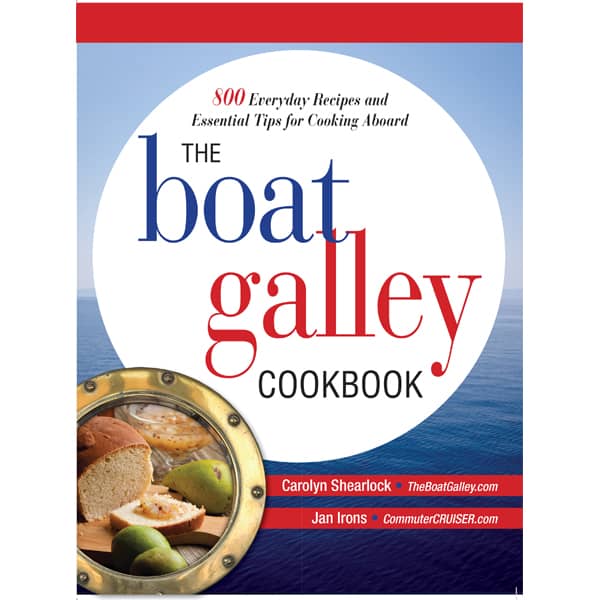
Storing food on a boat is more complicated than in a home kitchen. For one thing, the storage areas are different – there’s no walk-in pantry on a boat and a lot of your food will be stored in other areas of the boat, under settees or the floor. Most likely, the boat refrigerator opens from the top, so organizing it is different (read about that here). And finally, there are more hazards to protect your food from.
The five primary goals in storing food on a boat are to:
- Protect the food from the motion of the boat, which includes protection from crushing for fragile foods, as well as from chafing and breakage of containers;
- Protect the food from heat and humidity, which can cause spoilage much faster than in an air-conditioned house;
- Prevent a bug infestation;
- Make foods and ingredients as accessible as possible;
- Make efficient use of the storage space available so as to have sufficient food for the trip.
Every boat is different and there’s no “one size fits all” answer to these issues.
The weight that you’ll give each of the five goals in food storage will vary by where you’re cruising. For example, when we cruised the Sea of Cortez in the summer months — which tend to be very hot, with little wind — protection against damage from heat was a far bigger consideration than damage due to the motion of the boat. In the winter months, with lower temperatures but northers roaring through an average of once a week, the situation reversed.
Spend just a few minutes thinking about your food storage system in terms of these goals, and you’ll be a lot less frustrated when it’s time to prepare a meal.
One warning, however: expect to re-arrange things in your boat galley a few times before you’re satisfied. I changed things around several times in our first year of cruising, and after that I still made some changes as we traveled from one area to another and found myself buying somewhat different foods in different packaging.
It’s important to keep things you use most often in the most accessible places. Initially, I had a hard time with this, as I wanted to keep all of a certain item together. The reality, though, is that you can’t always keep your entire stock of something in an accessible place, but you can store enough for a few days or a week. For example, I kept canisters of pasta and rice right in the galley, but extra stores were in big plastic tubs under the floorboards, which were under a carpet. Once a week, I’d get in that locker and replenish stocks of everything stored there.
If the location of a particular item frustrates you on a daily basis, it’s time to change how you store it!
Read More About Storing Food

Carolyn Shearlock has lived aboard full-time for 17 years, splitting her time between a Tayana 37 monohull and a Gemini 105 catamaran. She’s cruised over 14,000 miles, from Pacific Mexico and Central America to Florida and the Bahamas, gaining firsthand experience with the joys and challenges of life on the water.
Through The Boat Galley, Carolyn has helped thousands of people explore, prepare for, and enjoy life afloat. She shares her expertise as an instructor at Cruisers University, in leading boating publications, and through her bestselling book, The Boat Galley Cookbook. She is passionate about helping others embark on their liveaboard journey—making life on the water simpler, safer, and more enjoyable.
Simplify meal prep on board with proven strategies for provisioning, maximizing fridge space, and cooking delicious meals aboard your boat.










Andrew says
Hi. Thanks for this. I came across your link at the liveaboards group. I am currently building a boat for long term out-of-the-way living aboard with my wife. One question I have (we both do) is how essential would you rate an on board freezer/fridge? I suspect that we will need one, although the wife figures she might like the challenge of not having one. So in your experience how useful and essential is it to have a reliable freezer that is always on? Thanks for your thoughts on this?
Carolyn Shearlock says
I’d rate a refrigerator and freezer fairly high, although I’d probably put a watermaker even higher if you plan to be away from “civilization” for longer than a week at a time.
In six years of cruising — Mexico and Central America — I only know of three boats that we met that didn’t have refrigeration. In the tropics, even more than the ability to store meat and veggies, was the ability to have cold drinks when it’s over 90 — or 100 — out.
Dave and I have done three extended camping trips — two months or more each — without refrigeration. Using canned meat is not a problem, and you can get by with canned vegetables and milk in boxes (one-quart size, like juice boxes, don’t need refrigeration until they’re opened). We found that we really missed fresh veggies and finally got a large 5-day cooler where we put block ice in the bottom under racks, and bins of fresh veggies on top (they now make an even better 6-day cooler). But this assumes that you can get ice every 5 days or so — and where we cruised, this would have really dictated our cruising “schedule,” making us go to “town” much more often than the 2- to 3- week provisioning schedule we preferred. Another consideration is eggs — while you can get unrefrigerated eggs outside the US fairly easily, you can’t in the US. And once eggs have been refrigerated, they have to stay refrigerated.
I understand your wife’s comment that the challenge of not having a refrigerator might be fun. I romanticized the notion of “living like the pioneers” (or at least like the Pardeys) and producing wonderful meals without refrigeration. And while I didn’t hate it on our camping trips, the novelty wears off quickly.
Before making your decision, I’d suggest an experiment: Duct tape the refrigerator and freezer shut (so you don’t inadvertantly get into it), then go to the store and stock up for a week. No more trips to the store for the week, no going to restaurants, no getting in the refrigerator. If you think you’d have a cooler on board, use it — but remember, no buying extra ice during the week.
Beth Leonard and Evans Starzinger have written two articles that are really on point, but it’s important to remember that they built Hawk for high-latitude sailing, where temperatures are much cooler than in the tropics (particularly a tropical summer):
What We Left Off Hawk
Keeping Food Without Refrigeration
Another quick point that I’ll make is that if you decide to install refrigeration, most people find that a 12-volt system is much more practical than engine driven. With engine driven, it’s hard to have a true freezer area, and in the typical pattern of spending time at anchor (or even in marinas), you don’t want to have to run the engine twice a day.
I’ve added this to the list of future article topics!
Andrew says
Thank you for the reply. Makes very good sense and I think we have pretty much decided that the reality is that we will need a freezer/fridge. Thanks again.
Danielle says
How did you guys store cheese aboard? I’ve heard of placing blocks of harder cheeses in containers and covering with enough oil to keep submerged. I’ve also heard of keeping waxed wheels in the bilge. Neither of these options seem very appealing to me…do you have any tips?
Carolyn Shearlock says
I was lucky to have a good-sized refrigerator, even if the back corner was a little hard to reach. I vacuum sealed my cheese (in its original plastic wrapper if it had one) and then put several bricks in a larger Lock & Lock plastic container in that back corner — then I’d get out one at a time and keep it in one of the more accessible bins as I used it. If you don’t have a vacuum sealer, you can use a freezer Ziploc bag.
I’d keep 1-pound cheddar blocks for 5 to 6 months this way.
I’ll give a few more ideas and details in a future article in this series — sign up for new article notices at the top of the right sidebar if you want to know when it’s posted. I’ve got a list of a bunch more topics to cover!
Danielle says
Thank you! And thank you so much for this informative site! I think I can speak for other cruisers (or even would-be cruisers) when I say you have great tricks that make the prep process a bit less daunting and overwhelmingly intimidating. I am eager to get a copy of your cookbook. Thanks again 🙂
Sami Bolton says
We have a small (about half++ the size of a normal single door house fridge) that switches from propane to 110 automatically and back again when necessary. It is one fantastic thing to have! It is a reasonable size for freezing a week or so worth of food….if not more depending on what it is, and tho it does not hold as much as our cold plate fridge and freezer (Jimmy Hoffa could have been stowed in either side) it is a normal stand up fridge and I love it. It even keeps ice cream frozen solid. It is a Dometic brand.
Tammy Swart on Facebook says
I spent quite a while “moving in” today. I will be looking back at articles I’ve read on your blog in past months to get pointers in the weeks to come. I’m really enjoying my first days in the new boat and can’t thank you enough for all of the information you’ve shared that will make our lives much easier!
LaMarr Harding says
I like chedar cheese. Mother would clabber it in a bucket in the sink. Then chedar it with a block press that kept the curds together under some wieghts. When she would get them out of the press she would wrap the discs in cheese cloth soaked in vinegar, and then seal that with parafin wax. The cheese would then be stored in the root cellar until used within a month or so.
If mold grew on a disc, she would cut the moldy skin off with a knife dipped in vinegar, and then rub the disc with vinegar and place it in a new plastic bag. It would last another week without growing mold.
50 years later I buy sliced cheese from a grocer. I’ve sometimes noticed mold growing on an edge, I slice off the offending cheese with a vinegar dipped knife, put it in a new plastic bag and I’ve gone another week without the mold reapearing.